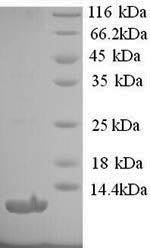The preparation of Recombinant Human AGTR1 protein included 3 main steps: construct the expression vector, expression of protein of interest, and protein purification. Every step was performed under a strict QC system so that we got the premium protein. This AGTR1 was expressed in Yeast at and fused with N-terminal 6xHis tag. According to SDS-PAGE, the purity turns out to be 90%+.
AGTR1 encodes the angiotensin II (Ang II) type I receptor that belongs to the family of G-protein coupled receptors. AGTR1 is an important part of the Renin-angiotensin system (RAS). AGTR1 has a strong influence on tumor growth, angiogenesis, inflammation, and immunity. Hypomethylation in the AGTR1 promoter had been validated to be inversely correlated with uric acid levels, which can be a significant risk predictor of essential hypertension (EH). Besides, AGTR1 methylation had been extensively studied in human cancers, such as oral squamous cell carcinoma. For example, a study showed that AGTR1 mediates breast cancer metastasis by regulating CXCR4/SDF-1α. Another study showed that AGTR1 promotes the invasion of breast cancer. Based on the pan-cancer analysis, researchers found that the expression of AGTR1 in most tumor tissues, including lung cancer, was significantly lower than the corresponding normal tissues and was related to prognosis.






